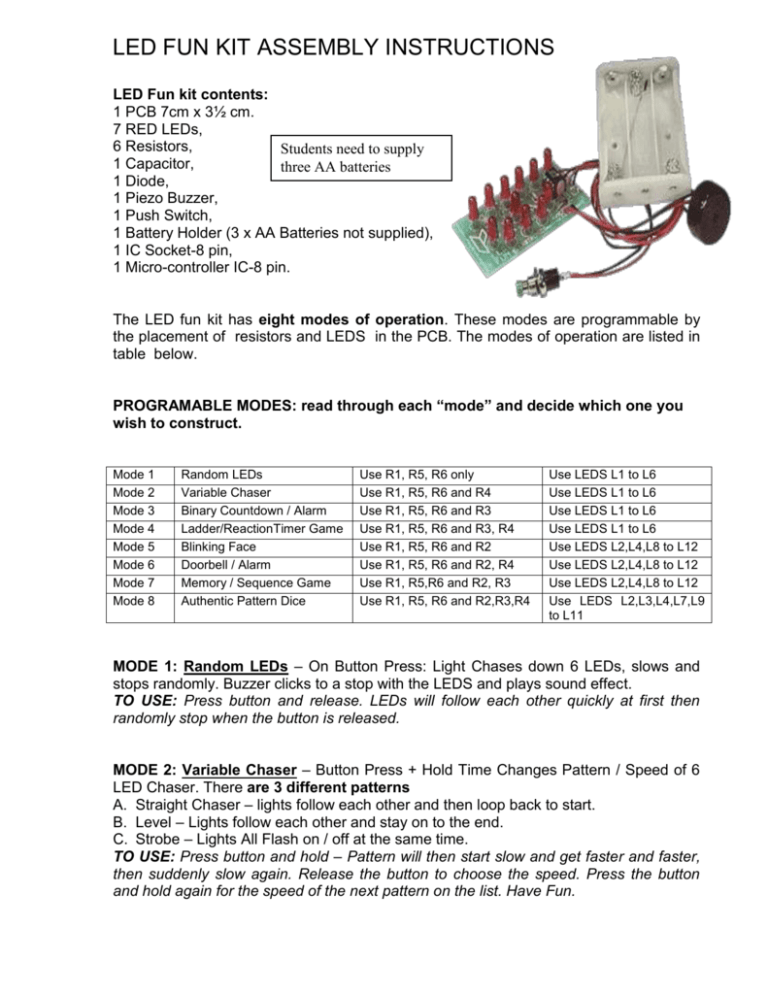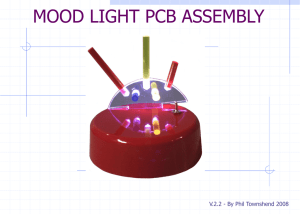LED FUN KIT ASSEMBLY INSTRUCTIONS
advertisement

LED FUN KIT ASSEMBLY INSTRUCTIONS LED Fun kit contents: 1 PCB 7cm x 3½ cm. 7 RED LEDs, 6 Resistors, Students need to supply 1 Capacitor, three AA batteries 1 Diode, 1 Piezo Buzzer, 1 Push Switch, 1 Battery Holder (3 x AA Batteries not supplied), 1 IC Socket-8 pin, 1 Micro-controller IC-8 pin. The LED fun kit has eight modes of operation. These modes are programmable by the placement of resistors and LEDS in the PCB. The modes of operation are listed in table below. PROGRAMABLE MODES: read through each “mode” and decide which one you wish to construct. Mode 1 Mode 2 Mode 3 Mode 4 Mode 5 Mode 6 Mode 7 Mode 8 Random LEDs Variable Chaser Binary Countdown / Alarm Ladder/ReactionTimer Game Blinking Face Doorbell / Alarm Memory / Sequence Game Authentic Pattern Dice Use R1, R5, R6 only Use R1, R5, R6 and R4 Use R1, R5, R6 and R3 Use R1, R5, R6 and R3, R4 Use R1, R5, R6 and R2 Use R1, R5, R6 and R2, R4 Use R1, R5,R6 and R2, R3 Use R1, R5, R6 and R2,R3,R4 Use LEDS L1 to L6 Use LEDS L1 to L6 Use LEDS L1 to L6 Use LEDS L1 to L6 Use LEDS L2,L4,L8 to L12 Use LEDS L2,L4,L8 to L12 Use LEDS L2,L4,L8 to L12 Use LEDS L2,L3,L4,L7,L9 to L11 MODE 1: Random LEDs – On Button Press: Light Chases down 6 LEDs, slows and stops randomly. Buzzer clicks to a stop with the LEDS and plays sound effect. TO USE: Press button and release. LEDs will follow each other quickly at first then randomly stop when the button is released. MODE 2: Variable Chaser – Button Press + Hold Time Changes Pattern / Speed of 6 LED Chaser. There are 3 different patterns A. Straight Chaser – lights follow each other and then loop back to start. B. Level – Lights follow each other and stay on to the end. C. Strobe – Lights All Flash on / off at the same time. TO USE: Press button and hold – Pattern will then start slow and get faster and faster, then suddenly slow again. Release the button to choose the speed. Press the button and hold again for the speed of the next pattern on the list. Have Fun. MODE 3: Binary Countdown / Alarm – Button Press sets a 1 - 64 second Binary Timer: Alarm sounds. USES: Can be used as a timer, a door bell, or as a security alarm. Games could be fashioned too, eg: pass the parcel party game. TO USE: Press Button and hold: Binary Counter will count up to 64 seconds. When the required time in seconds comes up, release the button. This sets the time. Now when the button is pressed, the counter counts for the required amount of time and then sets off a visible and audible alarm for 5 seconds. Time can be reset by pressing the button again. MODE 4: Ladder / Reaction Timer Game – Climb the 6 LED Ladder if your reaction time is quick. TO USE: When you hear a “ping” and an LED Flash you must press the button quickly to keep the LED lit. The next LED up the Ladder will flash and you must press the button quickly to keep it lit too – until you get to the top. Then all the LEDs will flash – well done. The first LED will start again but this time it will be a bit harder. How many levels can you get? MODE 5: Blinking Face – 7 LED Face Smiles & Blinks Randomly. Reacts to Button Press. USES: Make into a stunning Pendant, Broach or use as a face on a Robot or a Doll. You could even use it as an interesting night light for the baby. TO USE: Watch face change different expressions & make noises. Press button – to get a reaction MODE 6: Doorbell / Alarm – All off until Button Press: 7 LED Face Blinks & Smiles + Alarm sounds. Makes an interesting Door Bell – Face turns on too and smiles while alerting you. Could be used as a “Smiley Face” Alarm. TO USE: When switch is pressed, Smiley face alerts you to someone at the door with LED Face and Sounds Alarm. MODE 7: Memory / Sequence Game – Repeat the Sequence of Dot/Dash: 7 LED Face Happy or Sad. TO USE: Press button to Start / Release. The Buzzer and an LED will produce a series of beeps and pauses which you must repeat. The Face smiles and buzzer plays a tune if you are right. The sequences get longer and harder. How many levels can you get through? MODE 8: Authentic Pattern Dice using 7 LEDs for Dots. Chases & Stops Randomly on Button Press. Use where you would use a dice. Have more fun with dice games. TO USE: Press button and release. Dice “spins” more and more slowly until it stops on a number shown by an authentic dice dot pattern. INSTRUCTIONS FOR ASSEMBLY and CONSTRUCTION Check the PCB for damage and cleanliness Check that all components are supplied. Step 1. Insert resistors (all modes have R1,R5, R6 Insert and solder the 270 Ohm resistors to R1, R5 and R6. Insert and solder the other 270 Ohm resistors as per mode table. MODE 270 Ohm 1 none 2 R4 Only 3 R3 Only 4 R3 & R4 5 R2 Only 6 R2 & R4 7 R2 & R3 8 R2, R3 & R4 LEDs L1-L6 L1-L6 L1-L6 L1-L6 L2,L4,L8-L12 L2,L4,L8-L12 L2,L4,L8-L12 L2-L4,L7, L9-L11 Step 2: Insert diode Insert and solder diode to D1, taking note of polarity (black stripe) Step 3: Insert capacitor Insert and solder the capacitor to C1. (any direction for this type of capacitor). Step 4: Insert IC socket Insert and solder the 8 pin DIL socket to IC1; terminate with semi clinched terminations (see diagram) to the four corner pins only. Step 5: Insert LEDs Insert and solder the Red LED’s as per mode table taking note of polarity.(long leg is positive or mark flat part of the LED cap with a texta). Mount the LED’s between 5 and 6 mm off the board. Step 6: Insert battery holder wires Insert and solder the battery holder wires to BAT taking note of +ve (red) and –ve polarity. Cut the red and black wire provided to a suitable length (if in doubt just halve it) Strip the ends to about 3 mm and twist the wire tightly; then lightly “tin each lead” to enable tidy insertion into the holes in the board without splaying. Step 7: Solder in buzzer Solder wires on the back of the piezo buzzer element - one wire to the gold section and one wire to the silver section. Solder the other ends of the wires to B1 on the board. (any color wire) Step 8: Solder in switch Solder wires on the switch terminals and the other ends to S1 on the board (any way around). Step 9: Solder all components Solder the rest of the components once only. Step 10: Power board Solder a wire across one battery holder compartment. Insert 3x AA Batteries. Step 11: Insert IC chip Insert the IC into the DIL socket, taking note of the position of the pin one indicator. (there is a dot under the DIL socket) Step 12: Complete assembly Attach the battery holder, set up and test the unit. Electronics and Computer Systems Engineering






